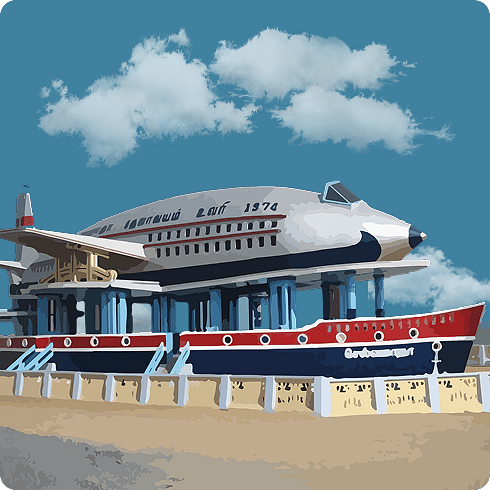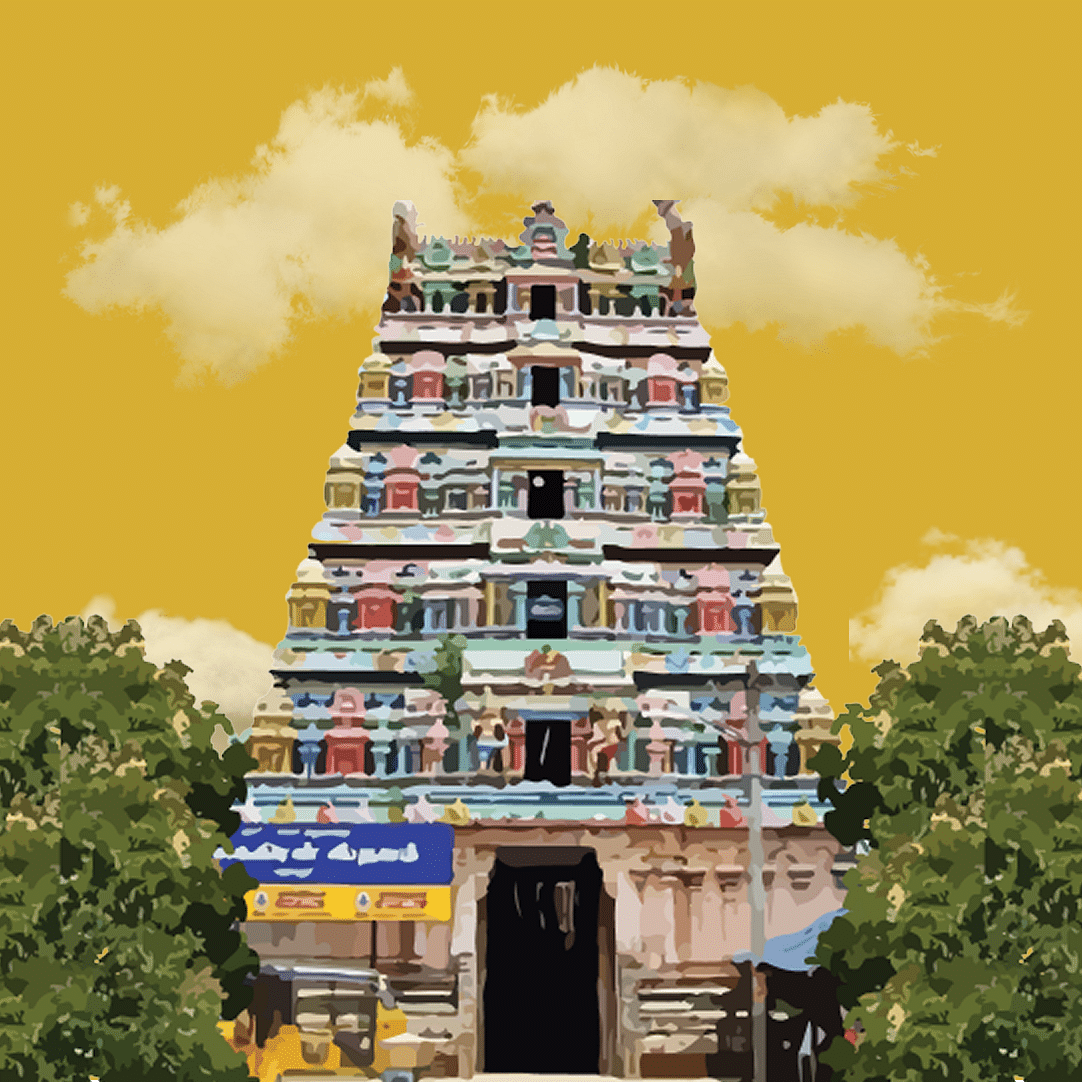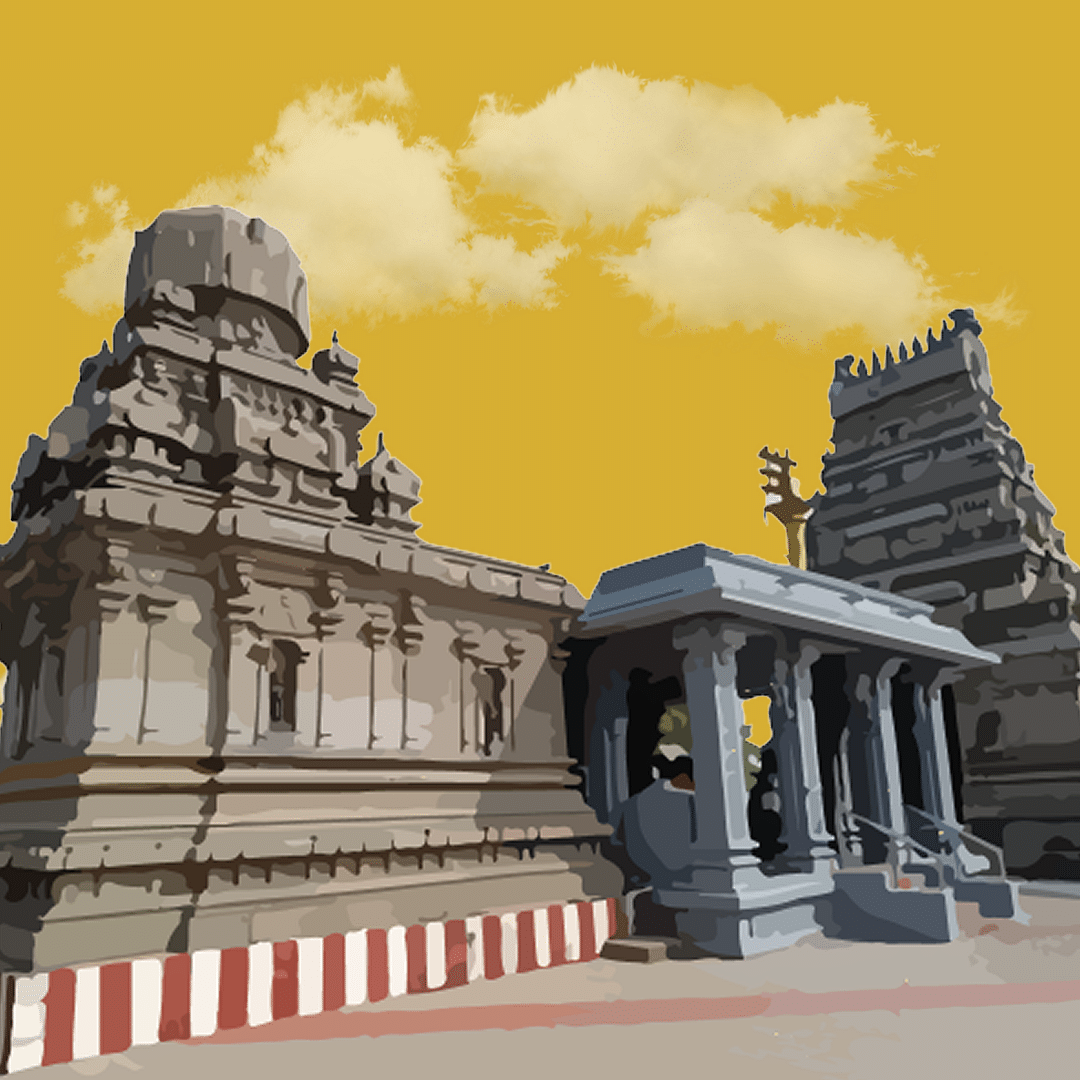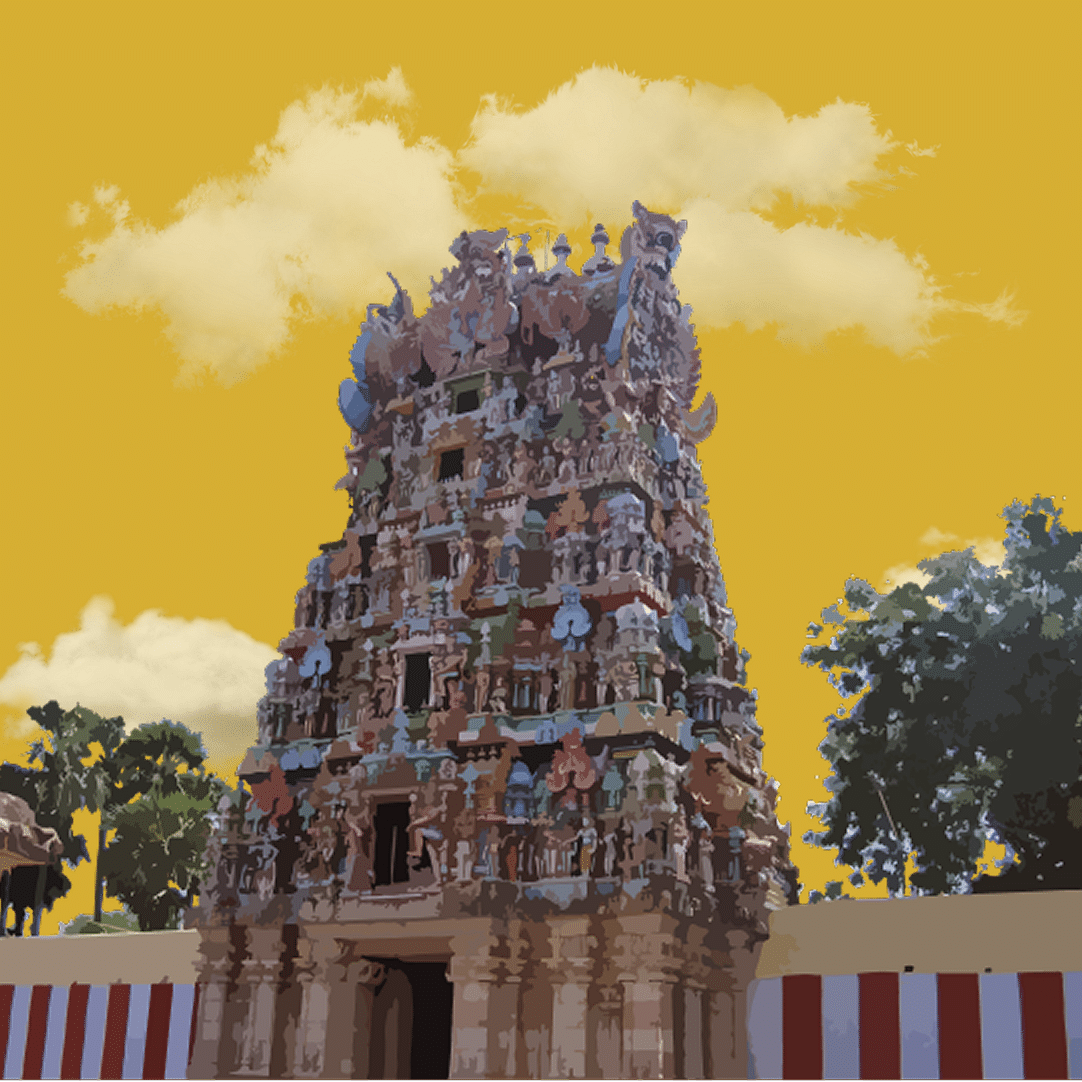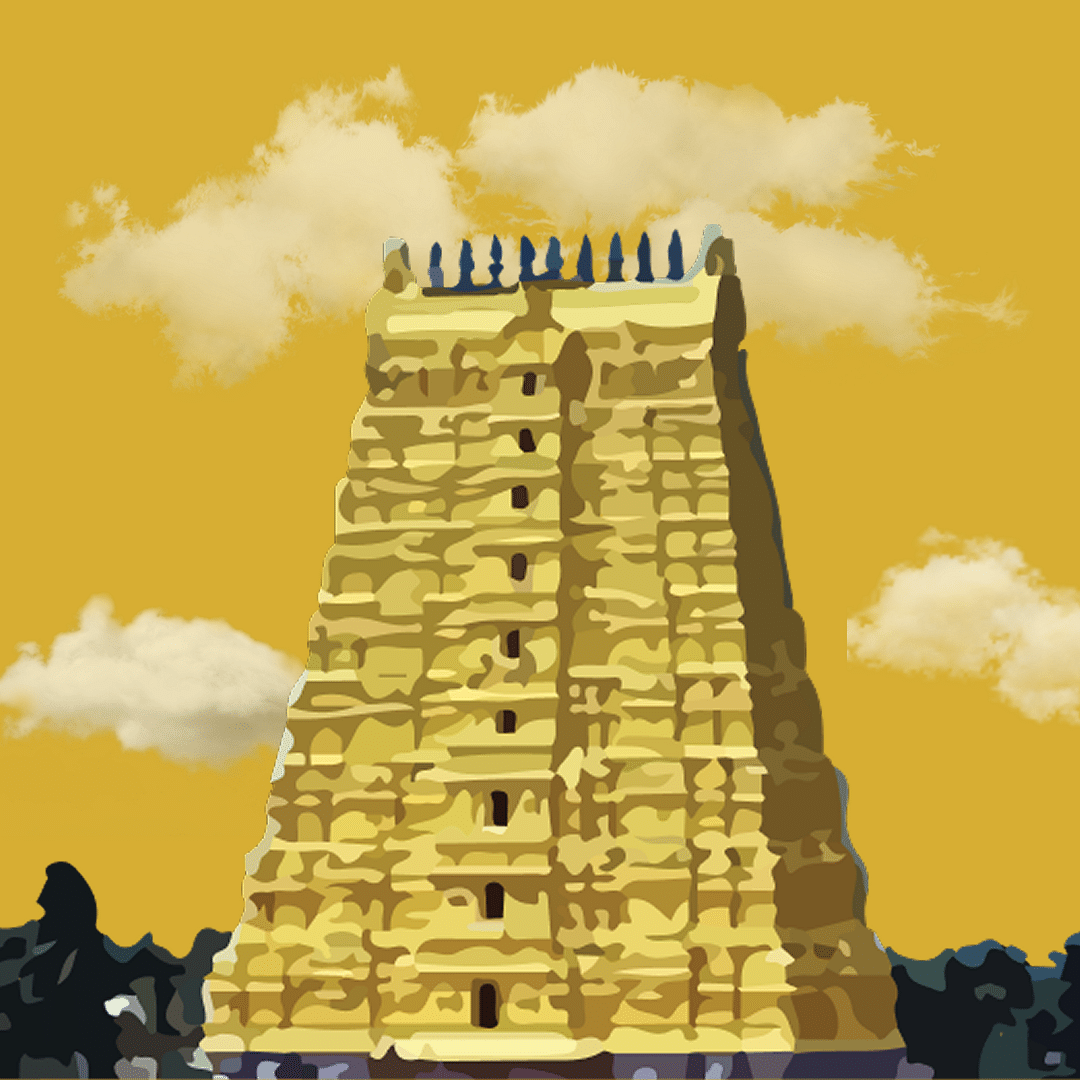Home > The GReaT Divine Darshan > Tuticorin
HOLY PLACES
IN TUTICORIN
Thoothukudi, the undisputed superstar of Tamil Nadu's coast, isn’t just a port city—it’s got more personality than your cousin’s wedding invite, and trust me, that's saying something. Known as the Pearl City, it’s been dropping treasures before influencers even knew how to pose with a coffee cup. With a coastline that flexes harder than your gym bro, and a history longer than your family WhatsApp forwards (yes, even the recycled jokes), this place has seen it all—Pandyas, Cholas, Dutch, Portuguese, British... and probably a few lost tourists who thought they'd ended up in Goa. And the food? Oh, honey, it's not just food—it’s a cultural experience that could change your life. From parottas so crispy, they might just break your heart, to curries that bring more heat than an April afternoon in Tamil Nadu, every bite is a celebration. The temples? Let’s just say, they’re the OG storytellers—standing tall with centuries of divine tales and spiritual vibes that hit different. The temples in Tuticorin, especially, carry stories etched in stone and devotion steeped in time. Festivals here are basically full-blown fashion shows with kumbhams, face paint, and thappattam beats. Whether you’re here for some sea breeze therapy, temple tales that make you feel like you’ve time-travelled, or just for a fish fry that could change your entire existence, Thoothukudi does it all—no drama, just straight-up magic.
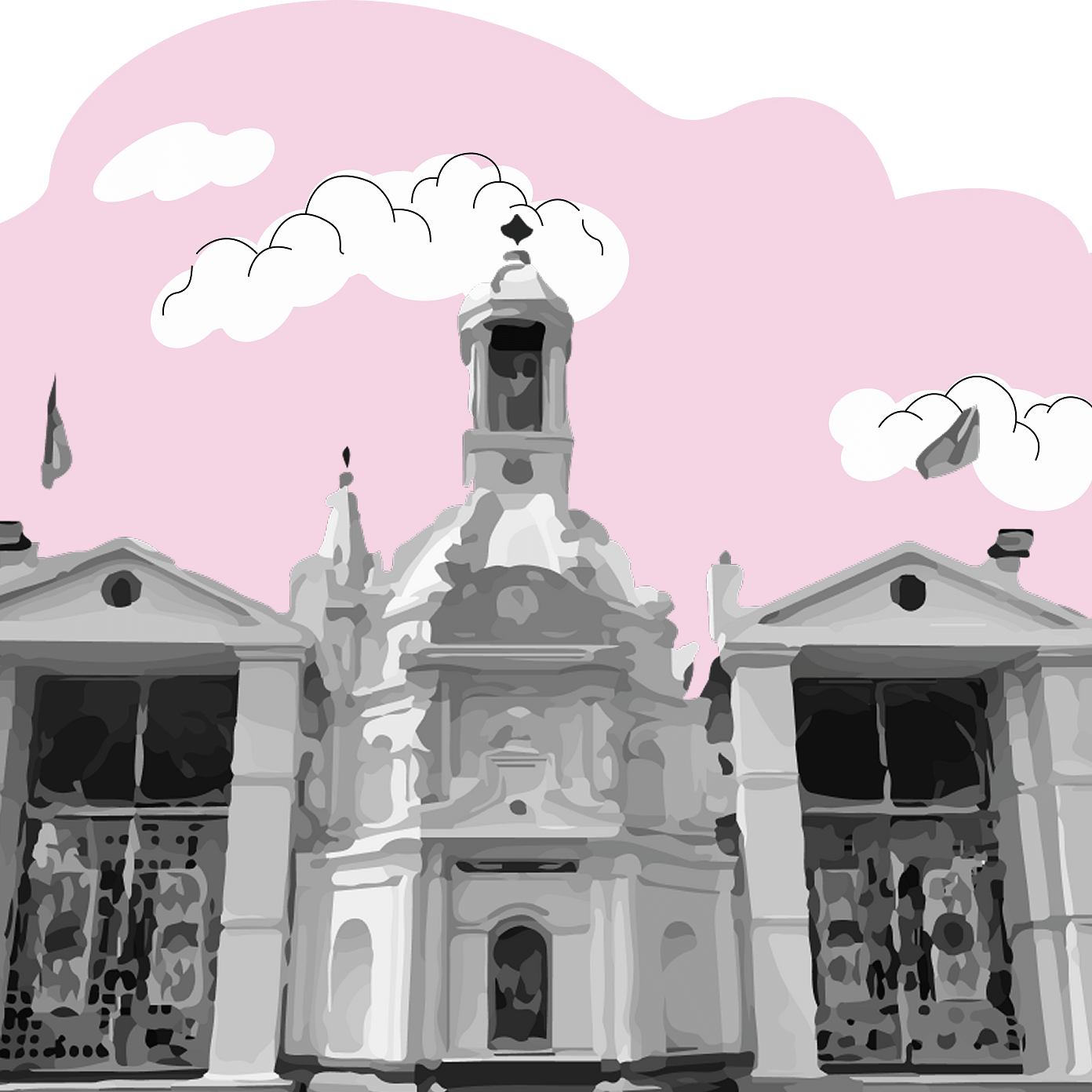
 OUR Hotels
OUR Hotels
IN THE CITY, BY THE SACRED SITES 🏙
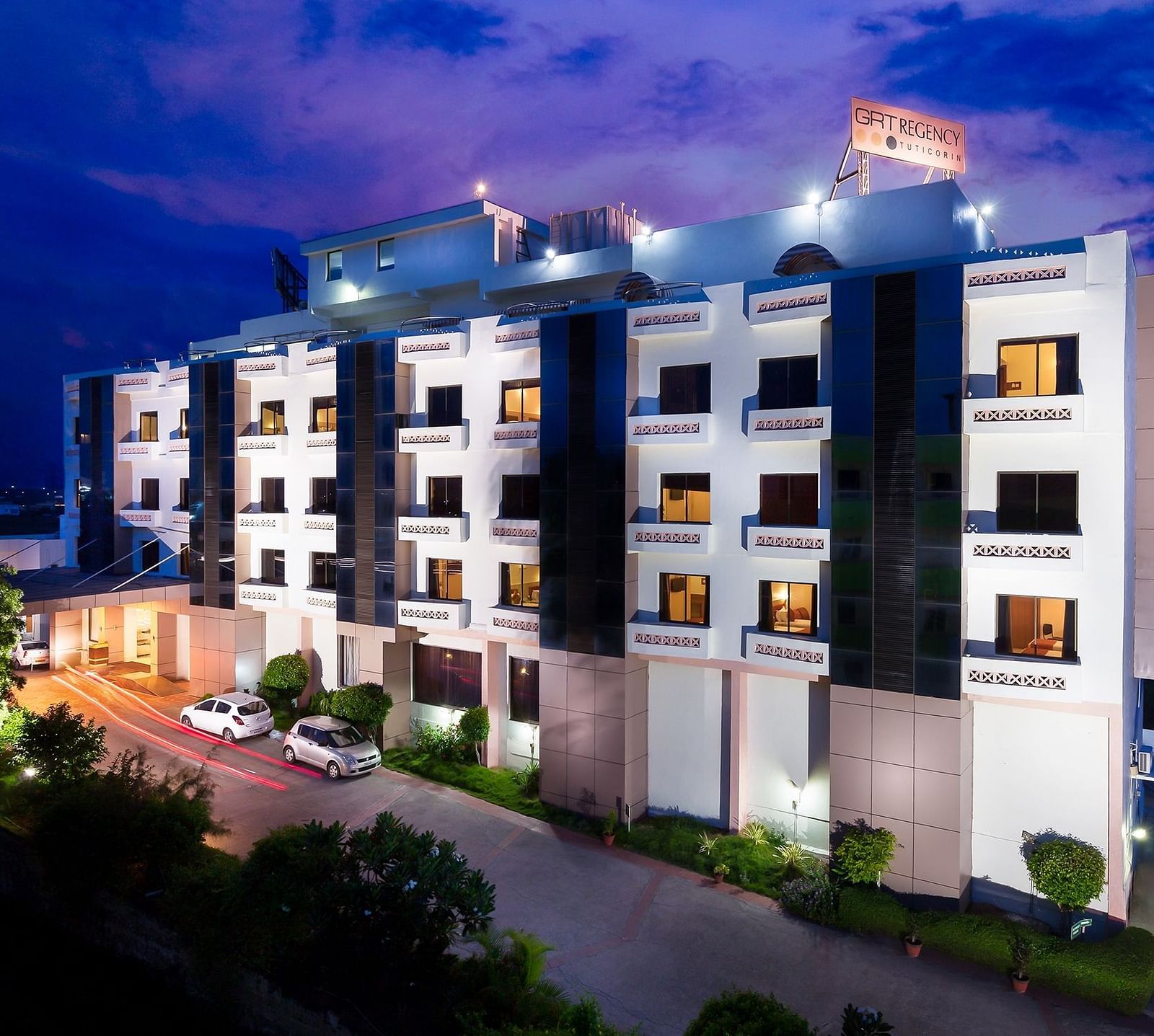
Regency Tuticorin by GRT Hotels
Plotting a trip to Pearl City, where the breeze smells like salt, seafood, and success? Drop anchor at Regency Tuticorin by GRT Hotels—your breezy basecamp in the land of ports, pearls, and parottas that could win awards. With 50+ rooms that are comfier than your post-meal nap and cooler than standing under the fan after walking in 40°C heat, we make checking in feel like a warm hug with A/C. The beds? So soft, even your alarms will give up. The service? Faster than your cousin forwarding memes on the family group chat. And the location? Let’s just say it’s the kind of prime real estate where you’re basically on the doorstep of history and spirituality. We’re talking a 300-year-old coastal temple and one of India’s oldest churches. Basically, we’re right in the heart of time itself—just with better pillows. Now, after you’ve soaked in some ancient vibes, it’s time to return to your retreat where peace meets puffed-up pillows, and your feet finally stop plotting revenge on you. And speaking of returning… let’s talk about food! Because, really, how can we not? Parottas that flake just right—crispy on the outside, soft enough to make you emotional.... Fish curries that taste like the ocean have finally learned how to cook. And chutneys? Fiery, fearless, and ready to steal the spotlight. Every meal here doesn’t just fill your stomach—it builds character. Whether you’re here for a temple trail, a work sprint, or just to dramatically stare at the ocean like a movie hero in slow-mo, Regency Tuticorin by GRT Hotels is where your story gets an upgrade, with extra sambar on the side.
 OURDivine Destinations
OURDivine Destinations
TRAVEL THROUGH THE MUSEUMS OF FAITH 🛕
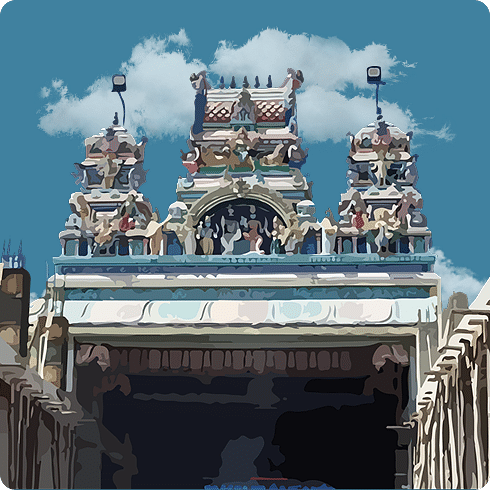
ARULTHARUM MUTHARAMMAN TEMPLE ✨
A 300-year-old coastal shrine, Kulasai Mutharamman Temple is a vibrant symbol of divine grace, folk tradition, and spiritual devotion in Thoothukudi.
Distance from Our Hotel10 km
Timing6:00 a.m. to 11:00 p.m.
4:00 p.m. to 11:00 p.m.FestivalDasara Festival: (Oct-Nov)
Sacred Food OfferedMahaprasad, Theertham, and Flowers
Transportation CostFor assistance, please contact the front desk.
Disclaimer: The temple's timings are subject to change as per the operating committee's decisions.
About Arultharum Mutharamman Temple:
- The temple is located in Kulasekharapatnam near Tiruchendur in the Thoothukudi district of Tamil Nadu, and is believed to be over 300 years old, reflecting centuries of local devotion and cultural heritage.
- The temple is situated approximately 14 km from Tiruchendur, making it a prominent pilgrimage spot in the region.
- The presiding deities of the temple are Goddess Mutharamman and Gnanamoorthy (Parvathi and Shiva), both depicted in a seated posture and facing north—a relatively rare orientation in temple architecture.
- Below the main idols, Lord Shiva is worshipped in the form of a swayambhu lingam (self-manifested), signifying the divine foundation of the shrine.
- The temple gives a central place to Mutharamman, much like Meenakshi in Madurai, making her the chief deity of worship and celebration in Kulasekharapatnam.
- Mutharamman is adorned with traditional ornaments, including a mangalsutra, symbolising her role as a divine consort and protector. Her right leg is folded, a pose that conveys both grace and readiness.
- Gnanamoorthy, seated beside her, holds a spectre (staff) in one hand and vibuthi (sacred ash) in the other, embodying wisdom and spiritual power. His left leg is folded, suggesting a meditative posture.
- The temple’s sacred tree is the neem tree, traditionally associated with healing, purification, and the presence of the divine feminine.
- In the mandapam (pillared hall) of the temple, other deities such as Petchiamman, Karuppasamy, and Bhairavar are also enshrined, reflecting the temple’s inclusive folk and guardian deity worship.
- Over the years, the temple has become not only a site of regular worship but also the centre of major cultural events, especially the Dasara festival, which draws massive crowds and features elaborate rituals and processions.
Divine Facts:
Once upon a divine time, a rishi named Varamuni thought he could skip the whole “respect your elders” rule and totally ignored Agastya, who’s basically a sage celebrity in spiritual circles. Agastya, not one to let it slide, threw a curse like a mic drop—Poof! Varamuni ended up with an ox head and a human body. Now cursed and looking like a mythological mascot gone wrong, he roamed around as Mahishasura, basically trying to strong-arm his way through life. The Devas (gods) and rishis were done with his antics, and like most people when things go sideways, they ran straight to Lord Shiva. Lord Shiva chose deep meditation, retreating into divine silence. In response, the gods and sages turned to Goddess Parvati, their hopes resting on her grace to restore cosmic balance. And true to her form, Parvati didn’t rush in—she arrived with the calm strength and radiance that only the Divine Mother can bring. Through a yaga (ritual fire ceremony), she sent forth a baby girl named Lalitambikai. Cute, but don’t let the swaddles fool you. In just nine days, this baby powered through her toddler years, teenage rebellion, and college degree in demon-slaying. On the tenth day, she levelled up to Parasakthi Lalitambikai—the ultimate divine warrior queen—and promptly slayed Mahishasura, ending his ox-headed reign of confusion. And just like that, Dasara was born! That victorious tenth day is celebrated with fire, flair, and fierce devotion, while the nine days leading up to it are observed as Navaratri—a cosmic countdown to Goddess power in full form.OUR LADY OF SNOWS BASILICA ✨
One of India’s oldest churches, Our Lady of Snows Shrine in Thoothukudi blends Gothic beauty with centuries of devotion, healing, and Tamil Catholic heritage.
Distance from Our Hotel10 km
Timing5:00 a.m. to 6:00 p.m.
FestivalAnnual Feast: (Aug)
Transportation CostFor assistance, please contact the front desk.
Disclaimer: The church's timings are subject to change as per the operating committee's decisions.
About Our Lady of Snows Basilica:
- Our Lady of Snows Shrine, also known as Panimatha Church, is located in the heart of Thoothukudi, Tamil Nadu, and was established in 1582 AD by Portuguese missionaries, making it one of the oldest churches in India.
- The shrine is dedicated to Our Lady of Snows, a title of the Blessed Virgin Mary, inspired by the Basilica of Santa Maria Maggiore in Rome, where a miraculous snowfall marked the site for a church in her honour.
- Originally a small chapel built by St. Jesuit missionaries, the church gained prominence over time due to its spiritual significance and growing Catholic community in the region.
- In 1610 AD, the church was elevated to the status of a parish, becoming the spiritual centre for Catholics in Thoothukudi and surrounding coastal areas.
- Over the centuries, the structure evolved into a grand edifice in Gothic architectural style, known for its soaring arches, intricate woodwork, and stained-glass windows that depict Biblical scenes and saints.
- The main altar, a striking piece of craftsmanship, features a magnificent statue of the Virgin Mary, exuding grace and devotion, and serving as the focal point for prayer and veneration.
- A significant moment in the shrine’s history was the installation of the miraculous statue of Our Lady of Snows, believed to have been brought from Manila, Philippines, by sea. Devotees consider it to have divine healing powers.
- The annual feast of Our Lady of Snows, held on 5 August, is one of the most important Catholic festivals in Tamil Nadu. It includes a grand car procession, novena prayers, flag hoisting, and masses attended by thousands of pilgrims.
- During this time, the church is adorned with lights and floral decorations, transforming the shrine into a vibrant centre of devotion, community, and cultural celebration.
- The shrine complex today includes accommodation facilities for pilgrims, a book and souvenir shop, and a support centre to assist those in need, enhancing both its spiritual and service-oriented role.
- The shrine remains open throughout the year, welcoming visitors of all faiths who come in search of peace, healing, and divine grace, with church staff offering warm hospitality and spiritual guidance.
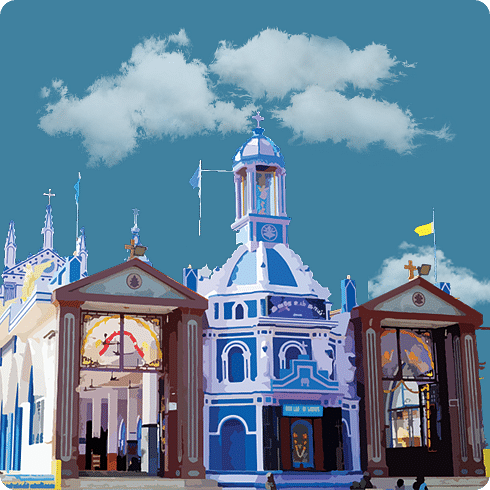
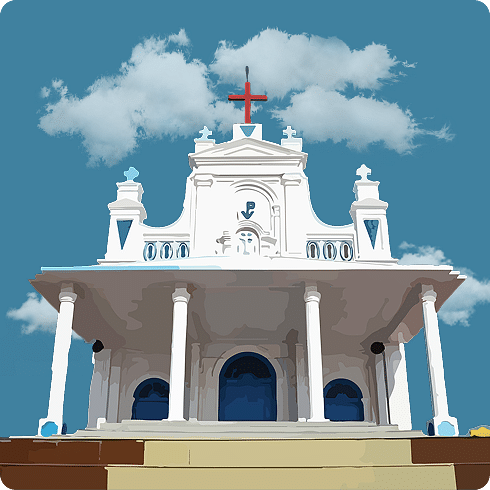
THE HOLY CROSS CHURCH, MANAPAD ✨
Set in the coastal town of Manapad, the 16th-century Holy Cross Church blends Indo-Portuguese heritage with spiritual grandeur, drawing pilgrims for its iconic architecture and the revered Feast of the Holy Cross.
Distance from Our Hotel10 km
Timing24 hours
FestivalHoly Cross: (Sep)
Transportation CostFor assistance, please contact the front desk.
Disclaimer: The church's timings are subject to change as per the operating committee's decisions.
About The Holy Cross Church in Manapad:
- This church is located in Manapad, a serene coastal town in the Thoothukudi district of Tamil Nadu, India.
- The church was originally established by Portuguese missionaries in the 16th century, around the year 1581, during the early wave of Christian missionary activity in South India.
- It was constructed near the spot where a Portuguese ship, caught in a storm, and was saved after the crew made a vow to erect a cross if they survived, thus giving rise to the name Holy Cross.
- The structure features a remarkable blend of European and Indian architectural elements, reflecting the cultural synthesis of its era.
- The church became a prominent centre for Catholic evangelism, drawing devotees from surrounding coastal regions and even from Sri Lanka during colonial times.
- Intricate murals, detailed altarpieces, and soaring Gothic arches were gradually added to the church interior over the centuries, enhancing its spiritual and artistic grandeur.
- The bell tower, a later addition, offers panoramic views of the coastal landscape and is renowned for its resonant chimes that echo across the town.
- The church has become a hub for annual feasts and processions, particularly the Feast of the Exaltation of the Holy Cross in September, drawing thousands of pilgrims.
- The local community has played an important role in the church's upkeep and cultural relevance, preserving its legacy as both a religious and social landmark.
- Today, the Holy Cross Church stands not just as a centre of faith but also as a living monument of Indo-Portuguese heritage, attracting visitors, historians, and pilgrims alike.
Divine Facts:
Back in the year 1540, when compasses were temperamental and Google Maps hadn’t been dreamt of, a Portuguese trading vessel bravely sailed the wild waters around the Cape of Good Hope, carrying both cargo and faith in equal measure. All seemed well until the sea decided to put on a show—a tempest so fierce, it shredded sails like paper and snapped the hind mast clean off, leaving the crew floating more in prayer than direction. As thunder rolled and waves danced like they had something to prove, the captain—known not just for his navigation but also his deep devotion to the Holy Cross—turned to the heavens. This wasn’t just a case of stormy weather; this was divine testing with extra waves. He made a vow, as many do when the sea gets louder than your thoughts: if they made it out alive, he’d turn part of the broken mast into a cross and plant it on the first safe shore they touched. A sincere promise from a sailor with no GPS, no sails, and a floating miracle mission. After drifting for several days, the ship didn’t just land anywhere—it gently washed ashore at Kulasekharapatnam, now near Manapad, like the sea itself knew the coordinates. The captain, true to his word, carved a cross from the very mast that had cracked under pressure but held onto faith. That humble cross—fashioned from storm and salvation—marked the beginning of a site that would one day become the magnificent Holy Cross Church of Manapad. Over time, with architectural flair and divine inspiration, what started as a sailor’s promise grew into a sacred sanctuary. To this day, the church stands not only as a beacon of devotion and architectural grace but also as a celestial reminder: sometimes, it takes a broken mast, a roaring sea, and an unshaken vow to anchor faith for generations.SELVA MATHA CHURCH ✨
Set along the Bay of Bengal in Uvari, the ship-shaped Selva Matha Church, built in 1974, is famed for its unique design and the annual 18th September chariot procession honouring Mother Mary.
Distance from Our Hotel74 km
Timing6:00 a.m. to 7:00 p.m.
FestivalChurch Festival: (Sep)
Transportation CostFor assistance, please contact the front desk.
Disclaimer: The church's timings are subject to change as per the operating committee's decisions.
About Selva Matha Church:
- Uvari is a coastal village in Tamil Nadu’s Tirunelveli district, located along the Bay of Bengal.
- It is home to the Selva Matha Church and lies approximately 72 km from Tirunelveli, 52 km from Kanyakumari, and 2.5 km from the Swayambulinga Swamy Temple.
- The original church dedicated to Mother Mary stood for many years but was eventually damaged due to severe sea erosion.
- In response, a new church was constructed in 1974, with a unique architectural design resembling an aeroplane placed atop a ship, giving it the name Kappal Matha Church (‘Kappal’ meaning ship in Tamil).
- The church faces the sea, and with the waves rolling in beside it, the structure appears as if it is sailing on water, enhancing its visual and symbolic impact.
- The inauguration of the newly built Selva Matha Church took place on 18th September, a date that is now celebrated annually with vibrant festivities and a grand procession.
- On this day, a grand procession is held through the town, during which the statue of Selva Matha is carried in a chariot, drawing large gatherings of the faithful.
Divine Facts:
In the quiet coastal village of Uvari, where the waves of the Bay of Bengal kiss the shore with timeless rhythm, there stands a church shaped like no other—a vessel of faith sculpted as an aeroplane upon a ship, lovingly known as the Selva Matha Church. Many years ago, under the serene cover of night, a group of young women—devoted in their hearts and pure in their prayers—made their way to the nearby nunnery, as was their tradition. Their evenings were filled not with grandeur, but with silent devotion, whispered prayers, and a yearning to be close to the Divine Mother. But one night, something extraordinary unfolded. As the women bowed in reverence before the statue of Selva Matha, a celestial glow began to rise, softly surrounding the figure of the Holy Mother. It was no ordinary flicker of light—it shimmered and swirled, encircling the statue in a halo of brilliance for over an hour as if heaven itself had descended to affirm her presence. The light did not go unnoticed. Villagers nearby, drawn by a sense of wonder, witnessed the divine spectacle. In hushed awe, they stood under the starlit sky, watching as this miraculous vision filled the space with sacred stillness. That moment—silent, glowing, unforgettable—was etched into the heart of the community forever. From that day on, 18th September has been marked as a day of great reverence and celebration. Each year, the town comes alive in spiritual unity. With beating drums, chanted prayers, and garlands of devotion, the statue of Selva Matha is placed on a beautifully adorned chariot and led in a grand procession around the village. The faithful walk beside it, heads bowed and hearts full, retracing the miracle that lit up their lives. For the people of Uvari, this is more than just a festival—it is a reminder that faith can shine brighter than any light and that the Divine Mother walks among them, sailing with them through every tide.